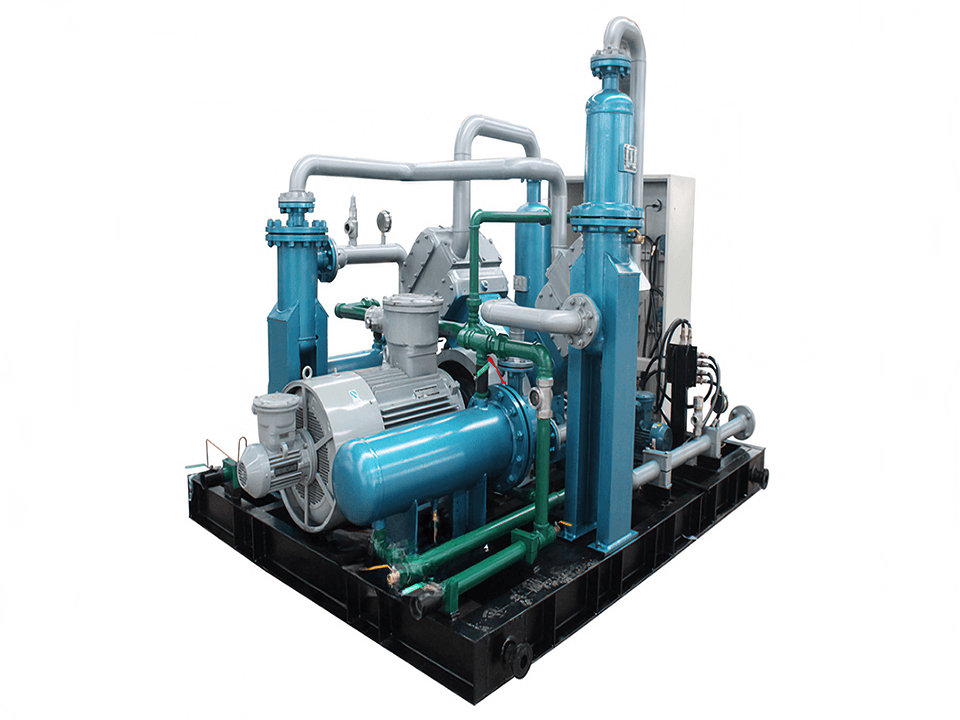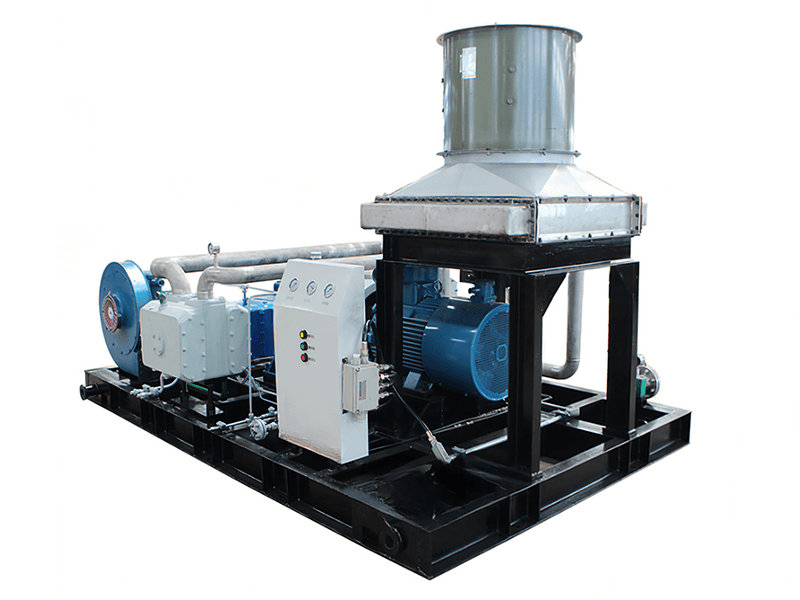A natural gas booster is a type of compressor specifically designed to increase the pressure of natural gas. It is used in various applications where the existing gas pressure is insufficient for efficient transportation, distribution, or specific industrial processes.
Natural gas boosters are typically used in natural gas pipelines, gas distribution networks, and industrial systems to overcome pressure drops that occur due to long-distance transportation, elevation changes, or high-demand periods. They ensure that the gas reaches its intended destination or application at the required pressure.
The primary function of a natural gas booster is to take in low-pressure natural gas and compress it to a higher pressure. This compression is achieved through various mechanisms, such as reciprocating pistons, rotary screws, centrifugal impellers, diaphragms, or other technologies.
Natural gas boosters are available in different sizes and capacities, depending on the specific application requirements. They can handle a wide range of gas flow rates and pressure ratios. The boosters can be powered by electric motors, natural gas engines, or other sources of energy, depending on the design and operational considerations.
These boosters play a crucial role in ensuring the efficient and reliable transportation of natural gas from production facilities to end-users, including residential, commercial, and industrial consumers. They help maintain the required pressure levels, optimize system performance, and support the safe and efficient operation of natural gas infrastructure.

Types of natural gas boosters
Natural gas boosters are used to increase the pressure of natural gas in pipelines or systems where higher pressure is required for efficient transportation or specific applications. Here are the common types of natural gas boosters:
1. Reciprocating Natural Gas Boosters: Reciprocating boosters use a reciprocating piston mechanism driven by an electric motor or a natural gas engine. The piston compresses the natural gas, increasing its pressure. Reciprocating boosters are known for their high efficiency, reliability, and flexibility in handling varying gas flow rates and pressures. They are commonly used in natural gas transmission, distribution systems, and industrial applications.
2. Rotary Screw Natural Gas Boosters: Rotary screw boosters utilize a pair of interlocking helical rotors to compress the natural gas. As the rotors rotate, the gas is trapped and compressed, resulting in increased pressure. Rotary screw boosters are known for their smooth and continuous operation, low vibration, and compact design. They are often used in midstream and downstream applications, such as gas gathering, processing plants, and natural gas vehicle fueling stations.
3. Centrifugal Natural Gas Boosters: Centrifugal boosters use centrifugal force to increase the pressure of natural gas. The gas enters the booster and flows through a rotating impeller. The high-speed rotation of the impeller imparts kinetic energy to the gas, which is then converted into pressure energy. Centrifugal boosters are known for their high flow rates, compact design, and suitability for applications with large volume requirements. They are commonly used in gas transmission, pipeline compression, and large-scale industrial applications.
4. Jet Natural Gas Boosters: Jet boosters operate based on the principle of ejecting a high-pressure motive gas into a converging nozzle. The motive gas entrains and compresses the low-pressure natural gas, resulting in a boost in pressure. Jet boosters are simple in design, compact, and suitable for applications where small pressure increases are required. They are commonly used in pilot plants, research facilities, and low-pressure natural gas systems.
5. Liquid Ring Natural Gas Boosters: Liquid ring boosters use a liquid ring, typically water or oil, to compress the natural gas. The rotating liquid ring creates a seal and compresses the gas as it moves through the system. Liquid ring boosters are known for their robustness, ability to handle wet or dirty gases, and low maintenance requirements. They are commonly used in applications such as vapor recovery, flare gas recovery, and handling gases with high liquid content.
6. Diaphragm Natural Gas Boosters: Diaphragm boosters use a flexible diaphragm that reciprocates to compress the natural gas. As the diaphragm moves, it creates a variable volume chamber, which compresses the gas inside. Diaphragm boosters are known for their oil-free operation, gas purity, and ability to handle corrosive or explosive gases. They are commonly used in applications where gas contamination or leakage is a concern, such as laboratory gas systems and gas chromatography.
7. Turboexpander Natural Gas Boosters: Turboexpander boosters utilize the expansion of high-pressure natural gas through a turbine to drive a compressor. The turbine converts the pressure energy of the gas into mechanical energy, which is then used to compress the gas to a higher pressure. Turboexpander boosters are known for their high efficiency, precise control, and suitability for large-scale gas processing plants and cryogenic applications.
8. Magnetic Natural Gas Boosters: Magnetic boosters use magnetic fields to create reciprocating motion in a piston or diaphragm, which compresses the natural gas. The absence of mechanical contact between moving parts reduces wear and maintenance requirements. Magnetic boosters are known for their oil-free and low-friction operation, long service life, and suitability for applications with stringent purity requirements.
Price range of natural gas boosters
The price range of natural gas boosters can vary widely depending on several factors, including the capacity, type of booster, brand, customization, and additional features. It's important to note that the following price ranges are approximate and can vary based on market conditions and specific project requirements. Here are general price ranges for natural gas boosters:
1. Reciprocating Natural Gas Boosters:
- Small to medium-sized boosters (up to 100 horsepower): $5,000 to $30,000
- Medium to large-sized boosters (100-500 horsepower): $20,000 to $100,000
- Large boosters (500-2,000+ horsepower): $80,000 to several hundred thousand dollars
2. Rotary Screw Natural Gas Boosters:
- Small to medium-sized boosters (up to 100 horsepower): $10,000 to $50,000
- Medium to large-sized boosters (100-500 horsepower): $30,000 to $150,000
- Large boosters (500-2,000+ horsepower): $100,000 to several hundred thousand dollars
3. Centrifugal Natural Gas Boosters:
- Small to medium-sized boosters (up to 100 horsepower): $10,000 to $50,000
- Medium to large-sized boosters (100-500 horsepower): $40,000 to $200,000
- Large boosters (500-2,000+ horsepower): $150,000 to several hundred thousand dollars
4. Diaphragm Natural Gas Boosters:
- Small to medium-sized boosters (up to 100 horsepower): $5,000 to $30,000
- Medium to large-sized boosters (100-500 horsepower): $20,000 to $100,000
- Large boosters (500-2,000+ horsepower): $80,000 to several hundred thousand dollars
5. Turboexpander Natural Gas Boosters:
- Turboexpander boosters are typically more complex and customized systems, and their prices can vary significantly based on project requirements. Prices can range from several hundred thousand dollars to several million dollars.
6. Liquid Ring Natural Gas Boosters:
- Small to medium-sized boosters (up to 100 horsepower): $10,000 to $50,000
- Medium to large-sized boosters (100-500 horsepower): $30,000 to $150,000
- Large boosters (500-2,000+ horsepower): $100,000 to several hundred thousand dollars
7. Magnetic Natural Gas Boosters:
- Small to medium-sized boosters (up to 100 horsepower): $5,000 to $30,000
- Medium to large-sized boosters (100-500 horsepower): $20,000 to $100,000
- Large boosters (500-2,000+ horsepower): $80,000 to several hundred thousand dollars
It's important to note that the prices provided are approximate and can vary based on factors such as brand, specific features, customization, and market conditions. The given price ranges offer a general idea of the cost range for each type of natural gas booster.
Additionally, it's crucial to consider that the prices mentioned above typically include the base cost of the booster unit itself. Additional costs may be incurred for installation, maintenance, accessories, control systems, and any necessary infrastructure modifications.
To obtain accurate and up-to-date pricing information, it is recommended to reach out to natural gas booster manufacturers, distributors, or suppliers who specialize in natural gas boosters. They can provide detailed quotes based on your specific project requirements, including capacity, pressure range, and any other customization needs.


























